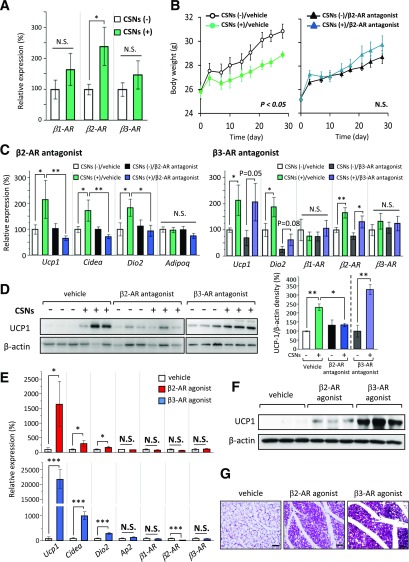Figure 4.
β2-AR mediates the capsinoids (CSNs)-induced beige adipocyte biogenesis. A: Relative mRNA expression levels of β1-AR, β2-AR, and β3-AR were measured by qRT-PCR in the inguinal WAT of mice fed an HFD supplemented with 0.3% CSNs (+) or vehicle (CSNs [−]) for 8 weeks (n = 6). Mice were kept under 17°C throughout the experiments. Data are mean ± SEM. *P < 0.05. B: Changes in body weight of WT mice fed an HFD supplemented with 0.3% CSNs (+) or vehicle (CSNs [−]) for 4 weeks (n = 6). The mice under 17°C were injected daily with vehicle (saline) or the β2-AR antagonist (ICI 118,551) at a dose of 2 mg/kg/day. C: Relative mRNA expression levels of Ucp1, Cidea, Dio2, Adipoq, β1-AR, β2-AR, and β3-AR were measured by qRT-PCR in the inguinal WAT of mice in panel B and mice injected with vehicle (saline) or a β3-AR antagonist (SR59230A) at a dose of 1 mg/kg/day. *P < 0.05, **P < 0.01. D: UCP1 protein expression was analyzed by Western blotting in the inguinal WAT of mice shown in panel B and mice injected with the β3-AR antagonist (SR59230A) at a dose of 1 mg/kg/day. β-Actin was used as a loading control. Quantification of the UCP1/β-actin is also shown (right). Density of UCP1/β-actin was calculated by ImageJ software. Data are mean ± SEM. *P < 0.05, **P < 0.01. E: Relative mRNA expression levels of Ucp1, Cidea, Dio2, aP2, β1-AR, β2-AR, and β3-AR were measured by qRT-PCR in the inguinal WAT of mice injected with vehicle (saline) or the β2-AR agonist (formoterol) at a dose of 1 mg/kg/day or β3-AR agonist (CL316234) at a dose of 1 mg/kg/day under ambient temperature for 1 week (n = 6). *P < 0.05, ***P < 0.001. F: UCP1 protein expression was analyzed by Western blotting in the inguinal WAT of mice shown in panel E. β-Actin was used as a loading control. G: Hematoxylin and eosin staining of the inguinal WAT of mice shown in panel E. Scale bar = 100 μm. Note that β2-AR agonist (formoterol) treatment led to a striking increase in the number of multilocular adipocytes in the inguinal WAT. N.S., not significant.

